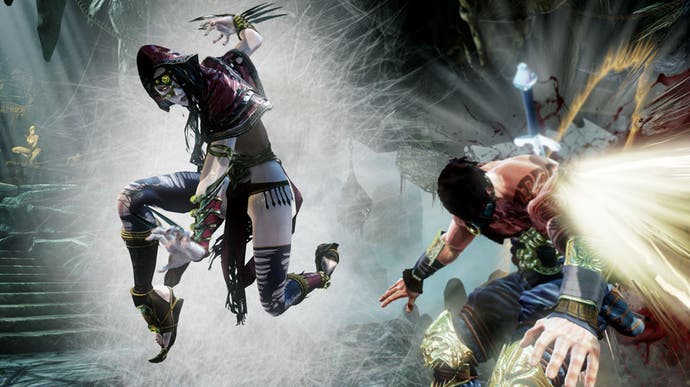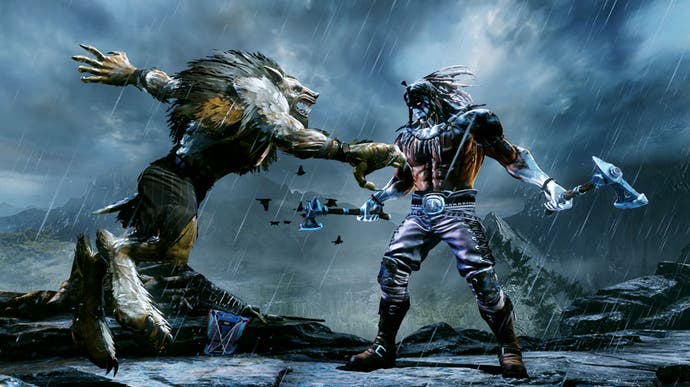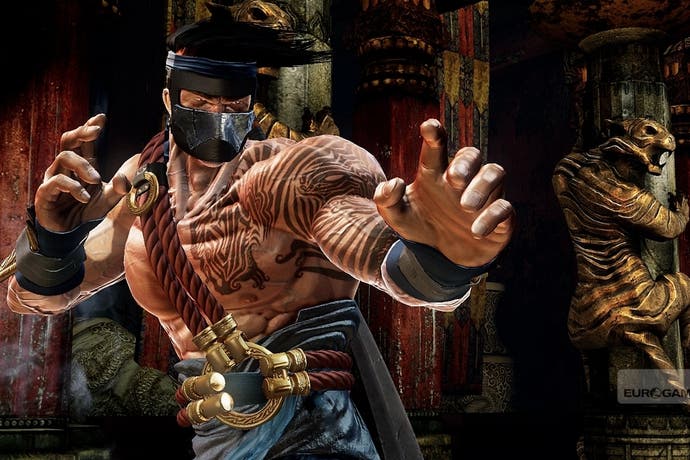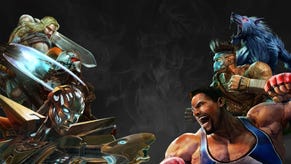Killer Instinct review
C-C-C-Come on Jago!
Fighting games are hard. For many they're impenetrable. Sure, you can do a hadouken; that quarter circle forward motion is ingrained in the psyche of most gamers of a certain generation, but beyond that? Well, things get complicated. And online? Forget it. Destroyed in the blink of an eye bruised by yet another meaty dragon punch.
So we come to Killer Instinct. Finally, a Rare classic made modern by the power of next-generation processors. But then, as more information trickled into view, reality bit deep down into our rose-tinted euphoria. For all the wide-eyed producers Microsoft's swollen Redmond-based Studios operation could throw at it, for all the passion veteran designer Ken Lobb could infuse in the project, and for all the feedback Rare, the creator of the original Killer Instinct housed half the world away, could send in emails read at the end of the British working day, the principal developer of Killer Instinct was Double Helix, creator of Silent Hill Homecoming, G.I. Joe: The Rise of Cobra and, er, Battleship.
Oh, and by the way, it's free-to-play, but you have to pay to buy characters. In a fighting game. I remember thinking, on the plane home from E3 in June, what a disappointment Killer Instinct would surely be. And yet, against all odds, Microsoft has produced a fun fighting game with a smart business model that's well worth a download after you unwrap your fancy new next-gen Xbox.
At a basic level, Killer Instinct works like Street Fighter 4. Its 3D characters battle on a 2D plane, so if you're standing to the left of your opponent you'll always face right. Like Street Fighter 4, Killer Instinct uses six buttons for attacks: three punches of varying strength, and three kicks, again of varying strength. An arcade stick or the Xbox One controller's d-pad (which, by the way, is the best ever created for fighting games) governs movement. Push right to move right across the screen. Push up to jump. Down to crouch. That sort of thing.
And like Street Fighter 4, special moves are triggered with established input commands. Jago, Killer Instinct's version of the father of fighting game all-rounders Ryu, has a special move set that mirrors his moody master. Quarter circle forward does a fireball. Quarter circle back does a kick that travels across most of the screen. And the shoryuken motion does a dragon punch. The brawlers themselves, all but one repurposed from the original Killer Instinct, are based on archetypes popularised by Street Fighter 2. Spy Orchid rekindles memories of special agent Cammy; rush-down specialist Sabrewulf works like Blanka; Glacius, whose long-range ice attacks combo from a full screen away, is Killer Instinct's version of Dhalsim; and the slow-moving but powerful Chief Thunder shares T. Hawk's love of high-damage command throws. Killer Instinct even looks like Street Fighter 4, with stylised, chunky characters that feel weighty. The choice of art style is smart - this a game with a werewolf and an alien made of ice, after all.
"The original Killer Instinct caught the eye for its huge combos, and this re-imagining is no different."

Killer Instinct comes into its own when you start to get to grips with its fun, fast and easy to grasp combo system. The original Killer Instinct caught the eye for its huge combos, and this re-imagining is no different. Combos start after you catch your opponent with what's called an opener: typically a special move but perhaps a jumping kick or punch. Once that connects, any basic attack continues the combo. Killer Instinct calls this an auto. From there, trigger a linker - again, typically a special move - from which you can perform another auto. You can keep this auto-linker-auto dance up for quite a while before the combo system forces it to end, or you end it with an appropriately named ender - usually a heavy special move.
The timing on basic combos is pretty forgiving, so pick up and play Killer Instinct and you'll just do stuff. If you can do an opener, mashing buttons and the quarter circle forward motion is usually enough to perform double-digit combos. And it's fun. Whether you know what you're doing or not, there is a satisfaction that comes from smashing your opponent in the face over and over again, and a guilty delight in the praise Killer Instinct's announcer, whose digitised screams could send armies off to war, delivers so liberally.
At first Killer Instinct comes across a little too combo-heavy, almost to the point of feeling mindless, but dig a little deeper and you discover mechanics that add depth to the system. Of course, Killer Instinct has those famous C-C-C-Combo Breakers. To do them, you need to press light kick and light punch, or medium kick and medium punch, or hard kick and hard punch, as your opponent uses the corresponding strength of attack during their combo.
Again, pretty easy, as far as fighting games go. Mashing buttons while you're being smashed in the face often triggers a combo breaker. It would be annoying if you couldn't protect yourself from combo breakers by replacing autos with the much-harder-to-time manuals. And, further encouraging variation, the game punishes failed combo breaker attempts by locking out another attempt for a few seconds. In this state you can, potentially, receive more damage than normal. As you play, you dig deeper: there are counter breakers, which counter combo breakers, which break combos. Killer Instinct's combo system is a virtual tug of war.
At higher-level play, combos are as much a battle of wits as they are a reflex challenge. You need to keep your combos fresh to prevent constant combo breakers, and when you're playing a foe who can combo break with regularity, you need good timing to throw in manuals and counter breaks of your own. The combo system rewards smart play. Those who mix up their combos, who successfully coax failed combo breaker attempts and repeatedly predict their opponent's attacks will more often than not win - and it's satisfying to do so.
Veteran fighting game players, though, may find Killer Instinct lacking after extended play. We'll see plenty of videos from expert players striving to achieve the highest combo possible, but the systems that fuel them are a tad basic. I suspect Killer Instinct will make a bright first impression on next year's Evo fighting game tournament, but it won't be a lasting one.
"This new Killer Instinct is better compared to League of Legends than some depressing mobile game."

Much was made of Killer Instinct's business model when it was announced. The free version is the entire game, but with just one character: Jago. You can fork out four quid to buy another character, or get all eight (two to be released post-launch - gah! Just make them available at launch Microsoft!) for a one-off payment of £16. When Ken Lobb described Killer Instinct to me as "the world's most generous demo", the internet scoffed, but it's a fair description. This new Killer Instinct is better compared to League of Legends than some depressing mobile game. The free character will be rotated, so even if you don't pay a penny, you should, after a certain amount of time, get to try out all the characters. My only grumble is there are just six characters available to play at launch. That's pretty feeble even for what is, essentially, the Xbox One equivalent of an Xbox Live Arcade game.
Talking of Xbox One, there's not much going on here that feels particularly next-gen. In fact, some of it feels distinctly last-gen. Online play works fine, but the lobby system is as bare bones as they come, and there's no way to spectate a match while you wait your turn. There's no arcade or story mode, either (like the two unreleased characters, Spinal and Fulgore, these are due later).
The graphics are crisp but bland. The character design is uninspiring. And the game's half-a-dozen stages are unremarkable. There's nothing about Killer Instinct that pops, that lingers long in the memory, that catches the eye even when you're laser focused on frame data. The fancy next-gen particles fade away like snowflakes, stylish but without substance.
All this does little to prevent Killer Instinct from being a success. Microsoft's mission was to create an accessible fighting game experience with a much-loved intellectual property and a business model designed to get as many people playing - even if it's Jago versus Jago ad infinitum - as possible. It achieves this with aplomb. Microsoft also set itself the arguably harder challenge of teaching people how to play fighting games. The superb dojo mode, which explains not just how the likes of cross-ups and buffer frames work but how best to use them, does this better than any fighting game I've ever played. Really. The dojo is amazing. All fighting games from now on need to step up.
Killer Instinct won't win awards. At the end of this new generation, it won't turn up in the lists of greatest console launch titles ever. And it won't cause the established fighting game creators - the Capcoms and Namco Bandais of this world - to fear for their jobs. But its heart - and its business model - are in the right place. Success!









